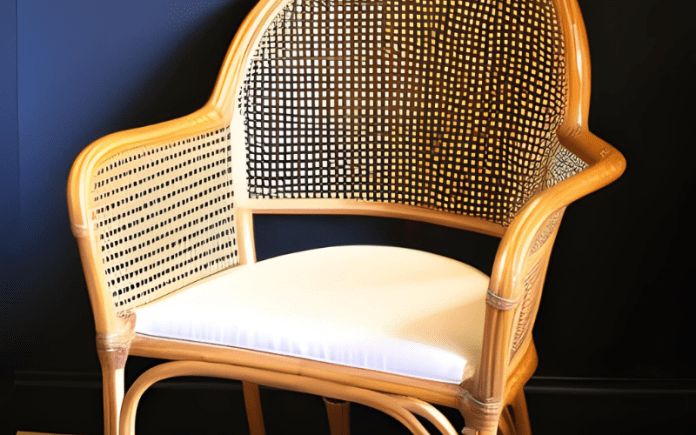NYC Chair Caning is NYC’s only custom machine & hand chair caning artisan restoring modern & antique chairs to their original beauty. The main form of caning is hole-to-hole traditional hand caning.It is woven into the groove routed in a chair seat frame and held in place with glue and a reed caning splint.
Re-Canning
Whether you have a pressed cane chair from the 1800s or a modern plastic woven cane chair, you can have it restored for very little cost. Chair caning is a time-honored furniture craft that dates back centuries and uses the same basic materials as it did then. Caning is a weaving technique that uses rattan palm (Calamus Rotan) to create strong chair seats and backs for chairs, ottomans, and other furniture.
There are two main types of chair caning – machine-woven and hand-woven. Machine-woven cane is pre-woven and is held in place with something that looks like a long piece of wood and is called a “spline”.
The other type of chair caning repair is hand woven and is threaded, as the name suggests, by hand through the holes around the edge of the seat frame or other area that needs caning. Hand-woven cane is much stronger than pressed cane and gives the chair a more traditional look. Determining how your chair was originally caned is easy; just look at the edges of the seat frame and back opening for a shallow ridge that probably has been filled with a spline.
Hand caning is a difficult and time-consuming process but well worth the effort for those who have the skill to do it. There is nothing more satisfying than restoring a family heirloom to its original beauty and function.
Re-Weaving
Chair caning is a centuries-old craft using the stem or trunk of a rattan palm (Calamus rotan) to weave seats and backs into wooden post and rail frame chairs, rockers, and settees. There are many types of weaving methods, but the most common is hole-to-hole traditional hand caning with a lacey open weave design.
Other weaving methods include splint chair caning, where flat cane is woven into holes drilled around the edges of a seat opening and held in place with a reed splint; and blind or French caning which uses strands of cane to weave a pattern into the wood, but without a formal octagon (8-sided) weave. Fiber rush and seagrass are also used for chair seat weaving as well as other areas like rim fillers or accent pieces.
Hand-caned seats can be stained to add color and/or age the seat to a more desirable finish. Cane is naturally shiny and doesn’t absorb stains as easily as wood, so it may require a bit of patience when staining. We recommend experimentation on scraps before applying a new coat to your caned seat.
NYC Chair Caning is NYC’s only custom machine & hand chair caning repair artisan restoring modern & antique chairs and furniture to their original beauty. To learn more about how to re-cane your own chair or purchase materials please visit the Caning Supplies page or call us today.
Re-Staining
If you want your newly re-caned chair to look its best, stain it. Staining rattan reed is a little different than staining wood since the outer layer of the reed is glossy and repels stain, but the inside ply is porous. If your chair has a light color and you want to darken it, try using a teak stain. Be sure to use rubber gloves and a mask when handling chemicals such as stripper. It’s also important to work in a well-ventilated area.
Having the ability to weave your own seat is not only a valuable skill for the home handyman, but it’s also a fun and profitable way to supplement your income by providing chair caning services on a part-time basis. If you’re interested in learning how to weave hole-to-hole traditional hand caning, also called strand or lace chair caning repair, consider taking a chair caning class.
Emza is an artisan who loves working on re-finishing and restoring modern and antique chairs and furniture. She has a strong emphasis on craftsmanship and perfection, both seen and unseen. She is a native of Clintonville and holds a BFA from Ohio State University with an MFA from the University of Colorado at Boulder. In addition to her extensive knowledge of weaving, she is a skilled woodworker and painter. She specializes in woven cane and refinishing, both of which she provides through her chair caning business, NYC Chair Caning.
Re-Upholstering
A great way to give a new look to an old chair is to re-upholster it. This requires removing the old fabric, pinning it wrong side up on the chair, sewing it together and adding welting to reinforce the seams. Once completed, the new upholstered seat cover can be placed on the frame and secured with screws.
To re-upholster a chair, you’ll need the following tools: Pliers or staple remover, Scissors, Screwdrivers (Phillips and flathead of varying sizes)
Before attempting to cane a chair for re-upholstery, it is important that it be ‘cane-ready’. This means that the holes drilled around the chair frame should be spaced about 1/2 inch apart and not have any large gaps.
Machine chair caning repair, also known as pressed cane, cane webbing, and sheet cane is a mass-produced process that uses a pre-made sheet of cane that is tamped into a groove that’s been routed out around the chair seat frame. It is far less time-consuming than hand chair caning and therefore, cheaper.
Hand Chair Caning, also referred to as strand cane or hole-to-hole cane is a traditional technique that involves weaving individual strands of cane through a series of drilled holes in a chair seat frame. It is more tedious and time-consuming than machine chair caning, which makes it more expensive.
